The Desk is an in-depth interview series with Arab Designers and Makers taking their desks as a focal point to view their practice. “The Desk’s” name is borrowed from Mark Gardner’s film of the same name. Mark’s short documentary sought to explore the relationship between a worker and their desk and how that reflects their personality. Design Repository is curious to explore the same while adding an intention of scribing these interviews in the Now and therefore attempts to record a moment in time for future generations so that they can find something about now when they look back.
The interviews will run around the year, with a new designer/maker and a new desk each month. Our next interviewee is the Egyptian designer: Engy Hashem.
Q: Please introduce yourself (Name, age, nationality, and title) and what do you do?
| Name | Engy Hashem |
| Age | 36 |
| Nationality | Egyptian |
| Title | Graphic Designer / Visual Artist / Corporate Art Consultant |
By profession, I go by the former titles, by identity I go by “Creative Practitioner”, a term I came across recently that I felt embodied the nature of my ‘being and doing’ – practicing creativity in a multitude of ways; presenting it; propagating it; making it. I have also found that conceiving myself within this definition helps relieve the pressure of the ‘career path’ concept. It allows me freedom to try new things, whether personally or professionally.
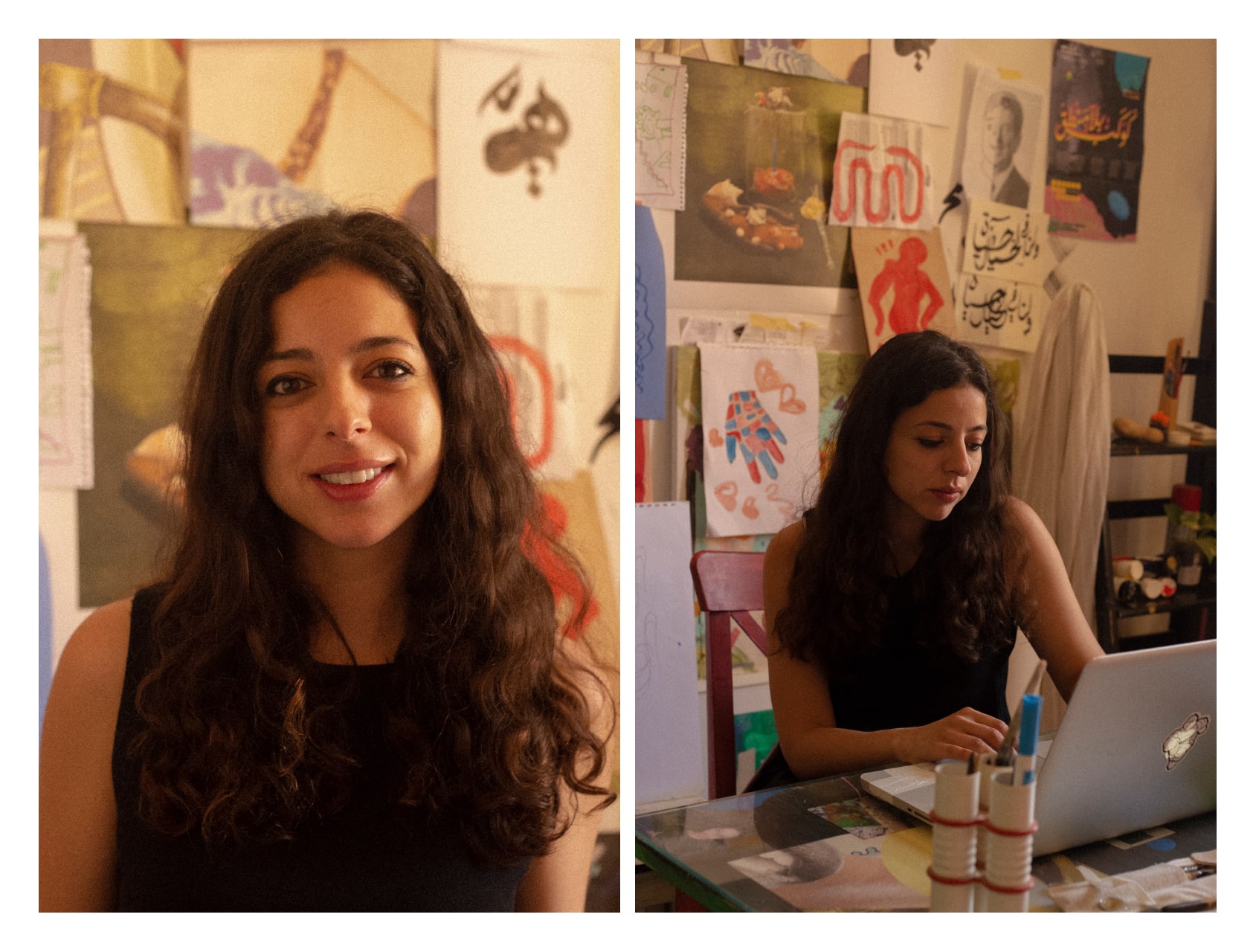
Q: You are a single mother of two beautiful girls and a designer, how do you juggle between those two?

A: Barely. On some days, ‘barely’ seems to be the term closest to the situation. On others, there is flow and I am able to balance both simultaneously. Farida and Nelly are of different ages and have different interests and needs, but Nelly who is four is pure havoc so most of the focus-driven work needs to be done after she is put to bed, before she rises, or while she’s swallowed in the metaverse playing Roblox.
They do, however, fuel a very primal creative side of me. My children generally prefer the messier, less disciplined side of things so they appreciate it when I endorse painting on tables or drawing on walls; impulsive paper pulp making, or impromptu acting theatrics.
Farida, my eldest, presents her creativity not only through palpable creations but also through wit and sharp tongue, constantly sharing reflections and stories about how she sees the world. I feel very privileged to be able to see matters through her and her sister’s perspectives alike.
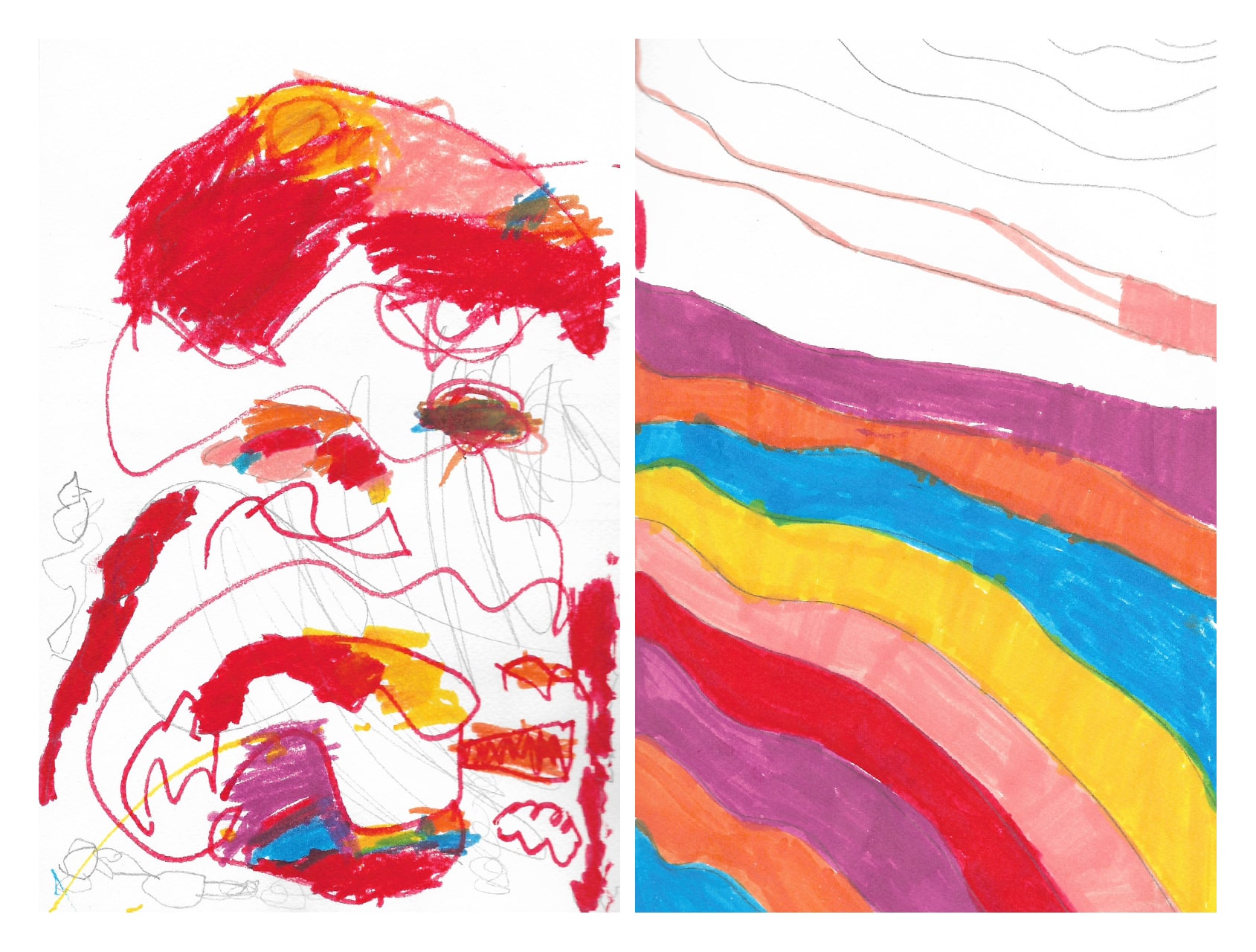
Q: You work across calligraphy, typography, illustrations, and sometimes moving images. What do you think are the benefits of having more than one skill in your arsenal as a designer?
✄
I think it speaks to the nature of the field and how it’s moving forward. I remain quite reserved when it comes to new technologies and techniques as developing a new skill requires time and resources that I can’t afford in the way that I could in my early career.
However, “dabbling” in different creative expressions comes naturally to me. It’s a desire, and an instinct to explore ideas through the lens of different mediums, regardless of whether it will end up being part of the final outcome.
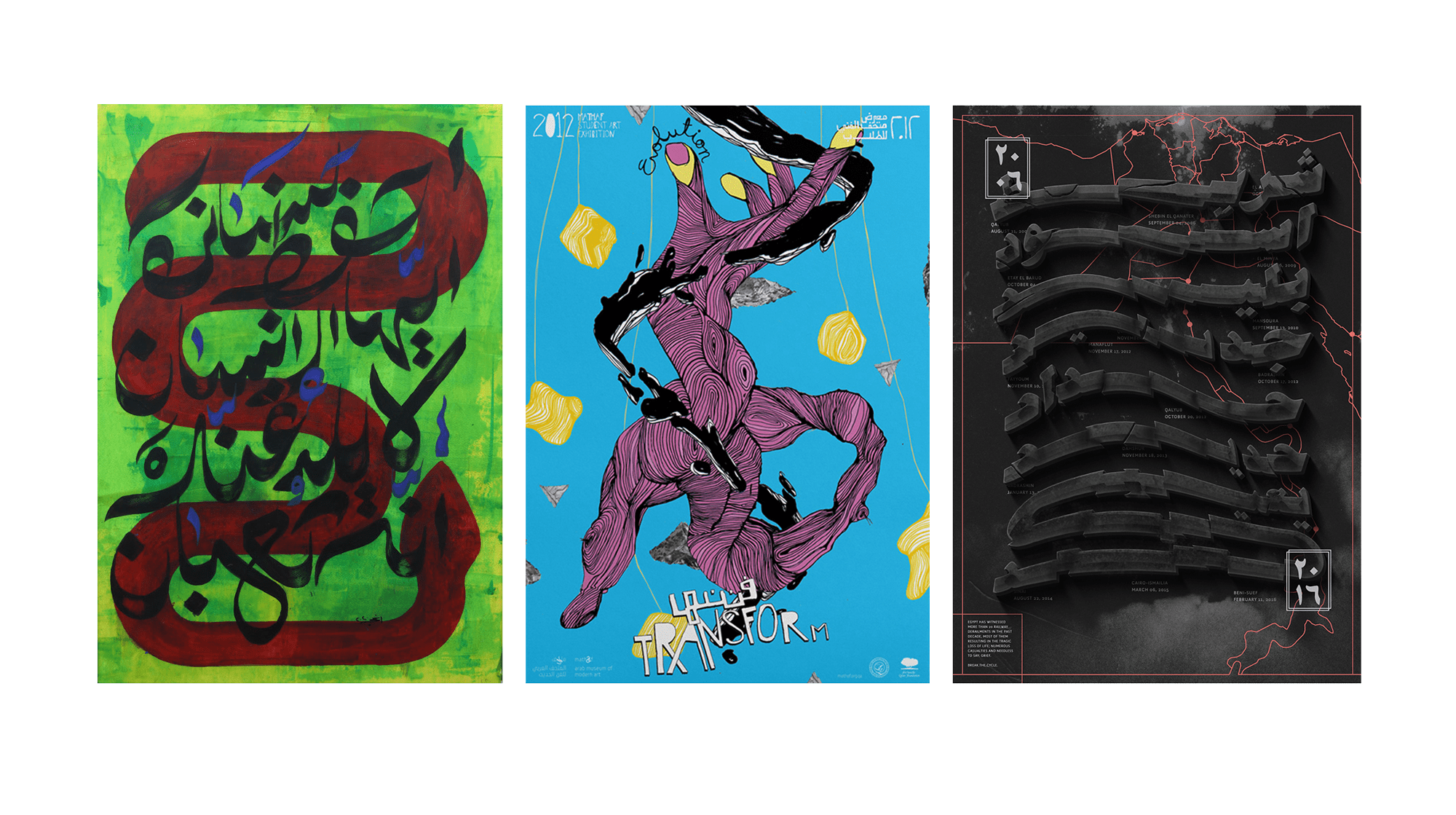
The way I see it is that everything is a story. Every person, object, piece of art, or design (architecture, furniture, a vase or otherwise) is telling a story, realized or not, intentionally or unintentionally. Various creative methods and skills are vital for me to be able to narrate these stories, be it for myself or my clients in both the fields of design and art.
Studying Graphic Design is one thing; it may hone your initial skills in composition and typography. However, with the constantly evolving nature of the field, from static to dynamic to interactive, eventually, what you want the project to achieve will dictate its best suited tools.
Q: Can you take us through your design process? Choose your favorite project and please walk us through its process from start to finish, challenges, and learnings?
✄
One of my favorite projects to date is the Khatt book. ‘Khatt: Egypt’s Calligraphic Landscape’ (Published 2018).

In 2016, Basma Hamdy, design professor at Virginia Commonwealth University – School of the Arts in Qatar, contacted me with the proposition to design Khatt: a book that would feature collected photographs by Noha Zayed of found typographic and calligraphic written expressions. A longtime admirer of Noha Zayed’s photographic journalling on Instagram through both her personal and ArabicTypography accounts, I said ‘I do’ before she could finish her sentence.
This project coincided with me moving back to settle in Cairo after a lifetime in my former home, Qatar. In retrospect, the process of this project proved to be a unique homecoming practice that cultivated both my cultural and geographical understanding of my new home through a simmering process that spanned approximately three years.
What is unique about this project specifically is the dynamic that flows between the different agents in the process (designer and author/s). This dynamic requires an open-mind for a different process; resisting the urge to cannonade the process with ‘design fundamentals’.
Although the book is essentially a documentation of visual instances and findings in public spaces, the journey of the photographs themselves remains quite personal to the documentor, as stated in an excerpt from Noha’s essay titled “Trucks: A moving canvas”
‘…the truck itself is a medium for self- expression… In a way, it becomes his public voice. For myself, I imagine a further function, unconnected to the driver, one that I can’t quite put my finger on. From personal experience, it seems that just at the moment I need to know it, be reminded of it, be told of it—I look up and there it is, the message I was missing: a verse of scripture, a line of poetry, a quotation or a time-worn piece of advice.‘
The process of “Designing” in the context of the book became synonymous with ‘sorting, analyzing, deciphering, classifying, arranging, clustering, grouping, regrouping, and mapping.’ This usually happened through intimate and regular tete-a-tete conversations, which gave rise to important questions about the book’s overarching narrative: how do we structure the book, which taxonomy should we use – geographical, scenic, thematic or poetic?

In parallel, I commenced experimenting with various page layouts while working on a simple format for the invitation document to be sent to the contributing essay writers. This document included highlighted referential images that vaguely signaled the various chapters of the book to inspire and initiate the conversation.
The (still existing) shared Dropbox folder between Noha, Basma and I is indicative of the rigorous image compartmentalization process that took place. Working with this level of organization allowed us to be precise with the various ‘found calligraphy’, from tuk-tuks to food-carts to advertisements. We micro-organised to eventually macro-synthesize the overarching narrative which would encapsulate both the photography and the written pieces.
After a few iterations, we decided to loosely work with these categories;
- Writings on vehicles
- On walls
- About faith
- About consumerism.
In the process of analyzing the photographs, we realized an overwhelming dominance of two particular surfaces (vehicles and walls) and topics (faith and consumerism). Therefore, we decided to structure the book this way.
As someone without the attention span for long, meticulous writing, I bestowed upon myself the task of fabricating memorable chapter titles and short melodic intros for the agreed upon taxonomies. One was: ‘Text Sells’, a chapter focusing on consumerist based writings such as advertisements, decorative typography on street carts, and carefully lettered shop signs. This was an obvious play on the age-old ad expression ‘Sex Sells’, a nod to its competitive, unabating nature.
Another was ‘Mark my Walls’ a slight twist on ‘Mark my words’, which provided the context for both casual city scrawls and authoritarian announcements.
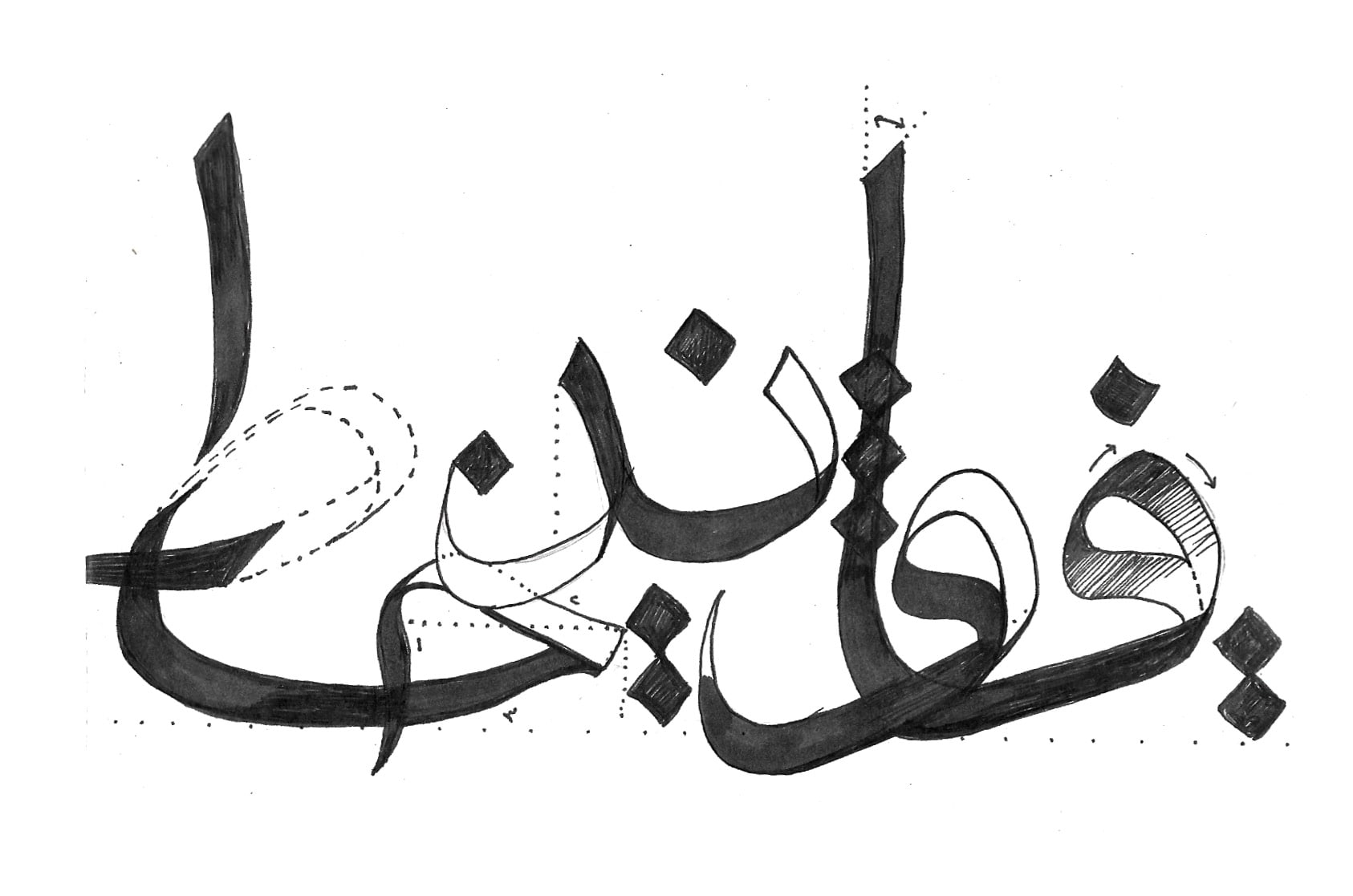

At some point in the process, all of these paralleled efforts needed to converge to create a cohesive final project. This resulted in overnight editing, image correcting and finalizing to meet the print house deadline, the last minute inserts and exclusions as if by divine intervention, and the multiple FINALKHATTFOLDERs. This project manifested an energy of deliberate safe keeping; to seek, to relish and to preserve, not only the growingly endangered art form of hand lettering but the intuitive connections and meanings within it.
Q: If you had to write a definition of Graphic Design for academic purposes, what would that be? And would you have a different definition of Arabic Graphic Design? If yes, what would it be and in what ways is it different?
✄
Graphic Design is a wide field. It is static, kinetic, sometimes poetic, other times basic; experimental yet straightforward; aiming at function and delivery but best if not directly so.
To make this more comprehensible, I would say that Graphic Design is an environmentally sensitive, culturally informed attempt to narrate, visualize and assemble data to articulate a message or specific amount of information coherently.
Regarding the aspect of ‘a different definition of Arabic Graphic design’, I attempted to answer this in the aforementioned; with the ‘design being culturally informed’. This could be addressing, questioning or hitting on aspects that are relevant to the culture, whether that being its local language, ideologies, practices, symbols or otherwise.
Q: Who are some of your favorite Egyptian designers/artists? One old and one current? Please feel free to add more than one if you feel like one is difficult to pindown.
✄
I’m terribly bad at remembering names and there are also designers that I’ve come across visually before knowing who they are. The multi-disciplinary storytellers resonate with my aspirations, so the artist-designer-activist-architect-human kind of creative, Others, I admire for their diligence and innovation in their chosen field. I’ll attempt to list them in order of historical revelation, or whose work I was introduced to first throughout my studies and career:
- Mohieddine Ellabbad
- Helmi Eltouni
- Adam Henein
- Hani Mahfouz
- Ganzeer
- Inji Efflatoun
- Omar El Nagdi
- Waleed Taher
- Salam Yousry
- Celine Raffy
Q: Who are your favorite non-Egyptian designers/artists? One old and one current?
Please feel free to add more than one if you feel like one is difficult to pindown.
✄
Plenty. Again in order of historical revelation:
- Jewad Selim- Iraq
- Nicholas Blechman – USA
- Mehdi Saeedi – Iran
- Rana Salame – Lebanon
- Mohamed Melehy – Morocco
- Homa Delvaray – Iran
- Mona Chalabi – Iraq / USA
- Lujain Abulfaraj – UAE
Q: How do you get inspiration for your projects?
✄
I’m reminded of a quote by Master Sculptor Adam Henein I came across in a documentary about his life (directed by Hesham El Shafie), where he said “I don’t believe much in inspiration. I’m not denying its existence, it’s there, but I don’t linger much there. The moral is, you enjoy what you’re working on, so you work on it all the time… inspiration comes from the act of working itself, it doesn’t come down on you from the outside.’
He went on to say ‘Well, what is basically the source of art? Art would certainly generate from nature. Man looks and sees and watches forms all the time and everywhere. He accumulates a stock of shapes and forms, the larger this stock, the richer the vocabulary of the artist.’
This is very good guiding advice to the deamer-experimenter-procrastinator type like myself; to focus on developing the work and to consciously enrich my vocabulary. So yes, I tend to take a lot of pictures. Especially during long walks and commutes. They’re usually of vernaculars; typography and calligraphy, patterns and color blocks, symbols and icons, and people – but low key with the people, as my observance of certain behaviors and body language including gestures are usually memorized rather than documented.
This collection of data (visual vocabulary) will usually initiate concepts for various projects, such as my entry for the Cairo Prints Exhibition (2021) “Fehras Al Tareeq.” This was intended to cite a selection of Microbus sign language witnessed along the infamous Ring Road.
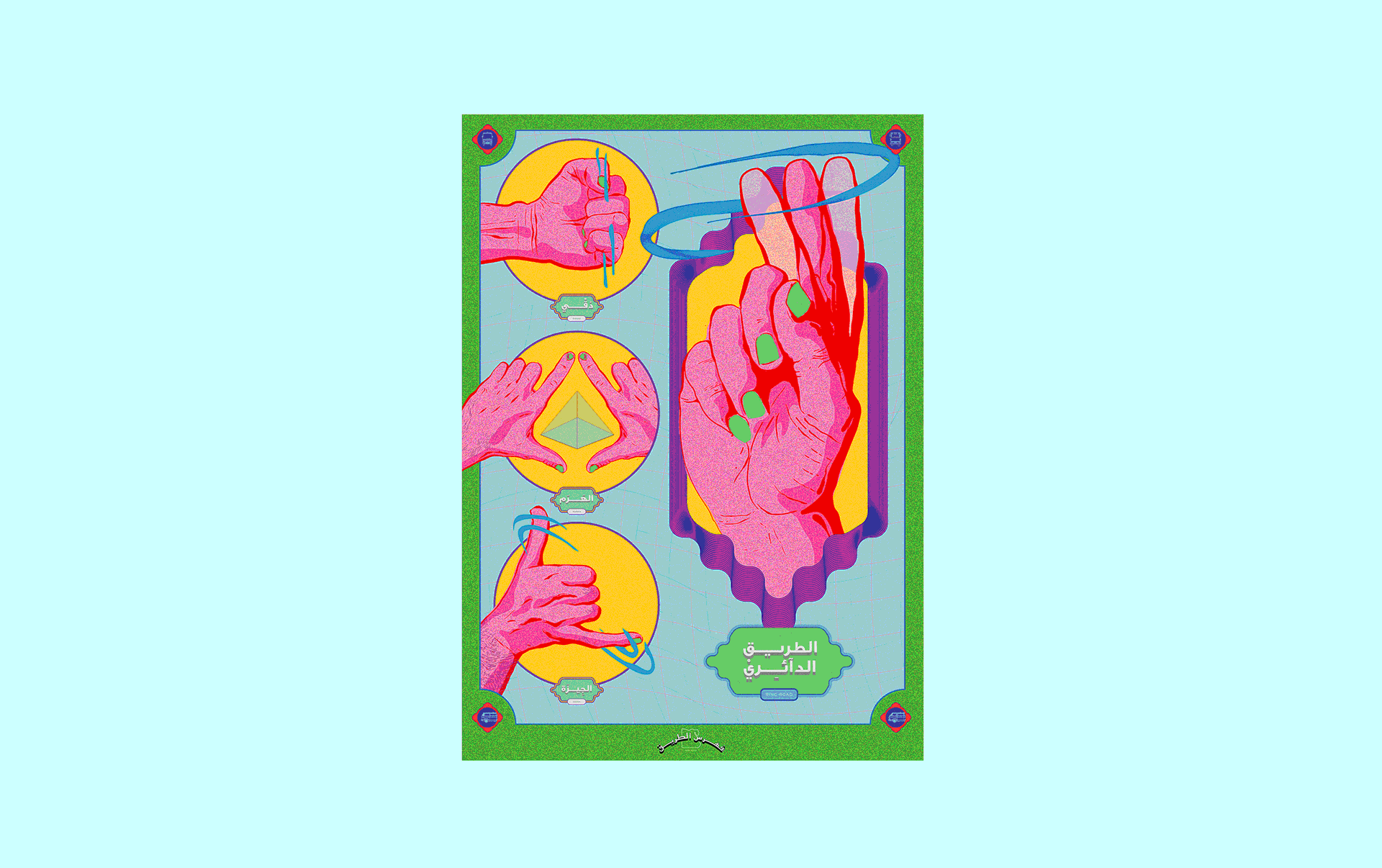
Looking up and reading into the different schools of art has also played an important role in cultivating (hopefully) a rich visual vocabulary; a journey that started while I was in school and persists till this day. There is always that name of an artist, painting or era in the back of your mind waiting to be revisited. Naive art (Primitivism) in particular is one of my favorites; both aesthetically and historically, and how it organically grew from being a ‘marginal’ art practice into a recognised art school. It is characterized with autodidacticism or self-learning, making it seem primitive or raw, but is very much rooted in authentic culture.
This primitive or self-taught nature is close to the exploration phase in my process or my children’s verbal articulations in an attempt to conceive meaning of the world as they grow. Engaging with my kids and being around these traits always reminds me to not lose this “naive” sense of wonder and curiosity.
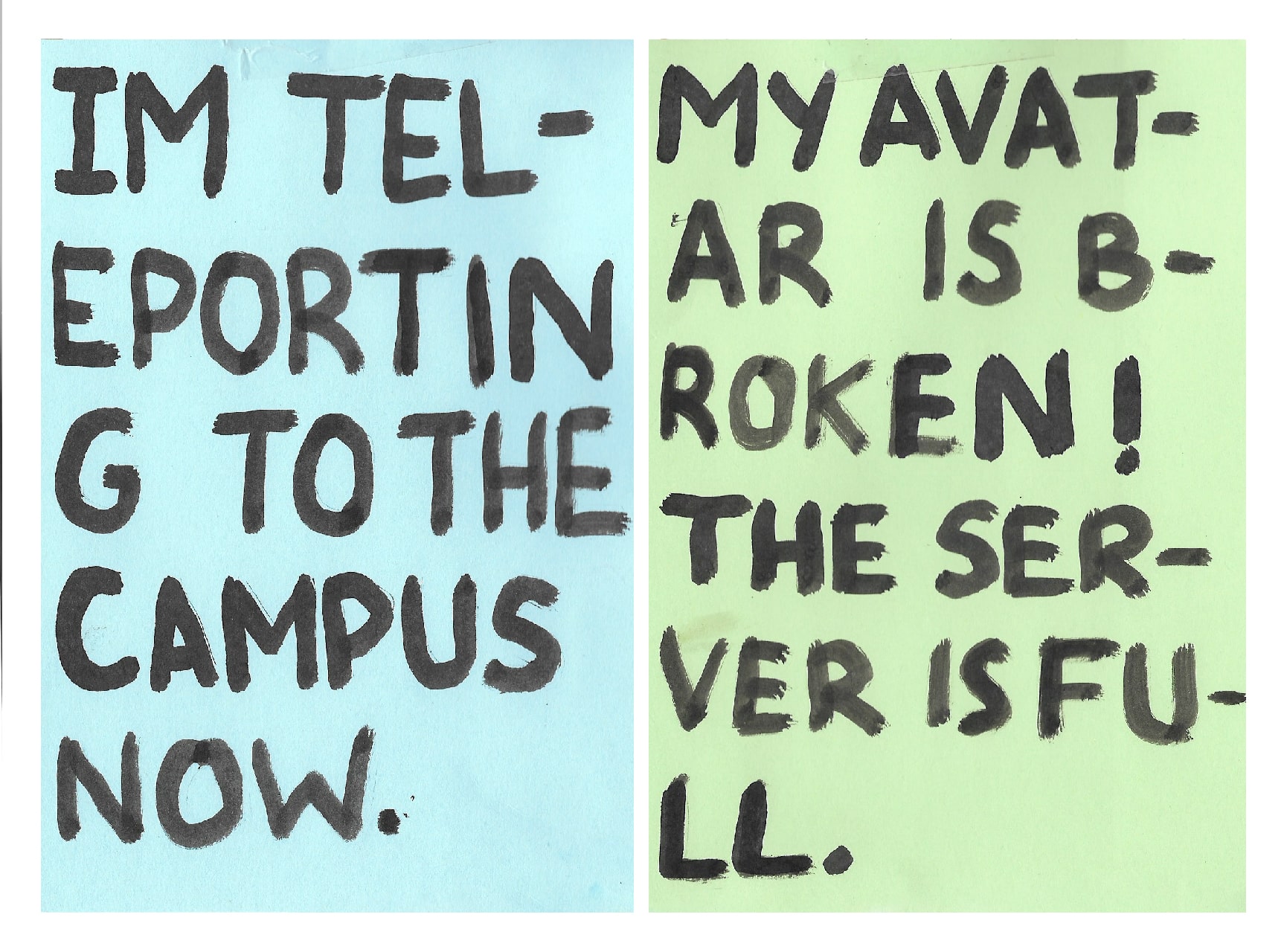
Q: You have a dense pinterest page with a lot of pinned topics, what do you think the role of pinterest and its similar platforms in the designers workflow these days?
✄
I was introduced to Pinterest in late 2011, nearly a year after its launch. I initially used it for personal interests, like grouping my favorite furniture, fashion styles or craft projects. With the design process, it comes in handy for a number of things: when curating mood boards, as visual stepping stones of sorts, to help clients understand the visual direction or tone of the project using reference imagery to support these different directions and rationals.
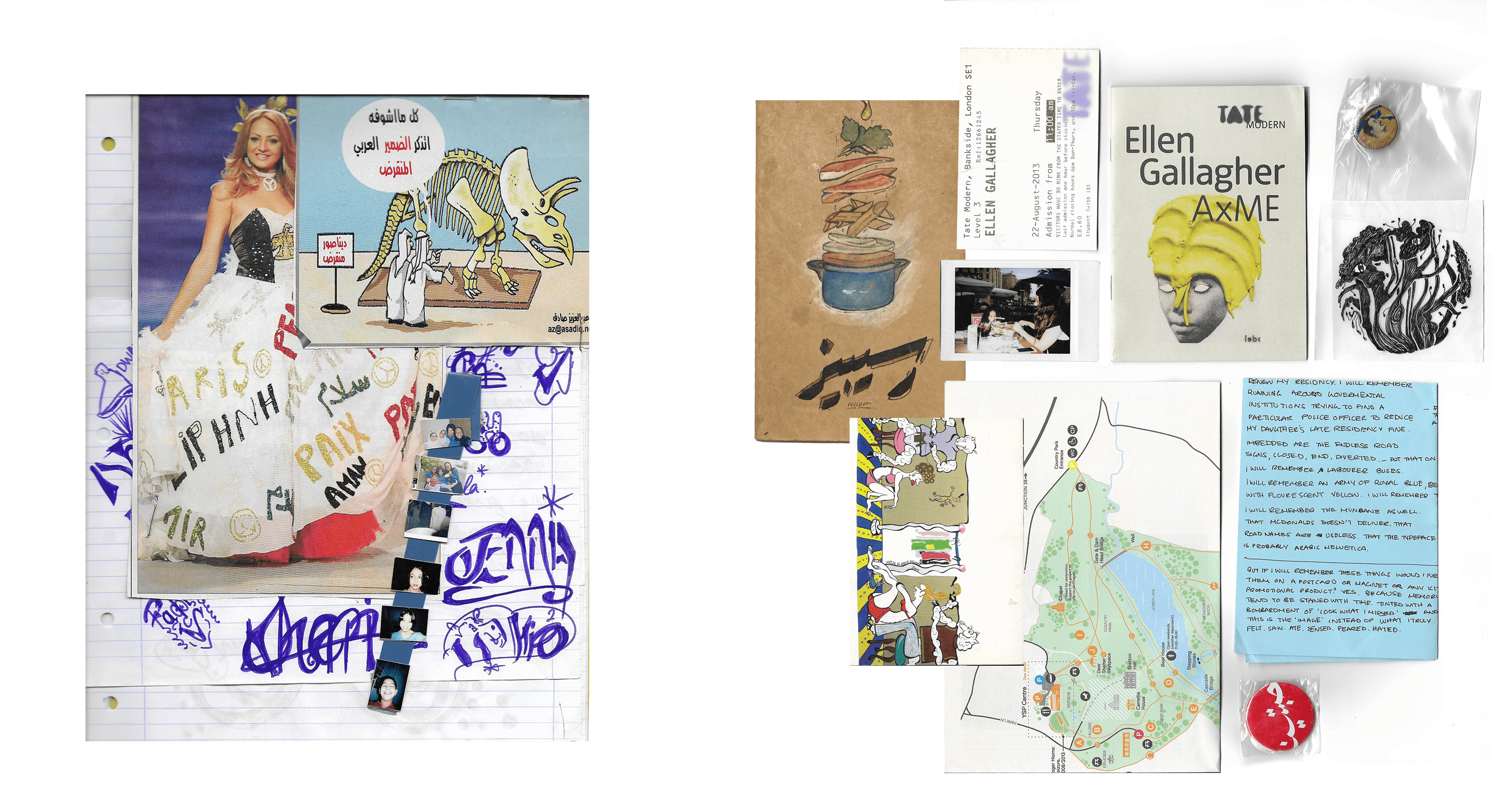
It also facilitates the collaboration process when working with a team, whether through multiple members curating a board and later discussing it or upload ing process work; allowing everyone to literally be on ‘board.’
The process of pinning on Pinterest isn’t too far off from collage making and scrapbooking; an activity I believe many of us either practice still, or are at least familiar with. Even the terminology of the platform pays tribute to the aforementioned. We have simply replaced scissors and tape with screenshotting and trackpad clicks.
Q: Describe what does your desk mean to you?
✄
I’ve had many desks during my time. Due to the nature of living in the Gulf, being born and raised there, no home is a forever home. So some desks I’ve had to forgo. When I moved to Cairo, I moved the essentials, this current desk being the official dining table at my former household in Qatar. It evolved during the past six years to be my go to desk for anything that requires a large flat space; mainly hand lettering and calligraphy.
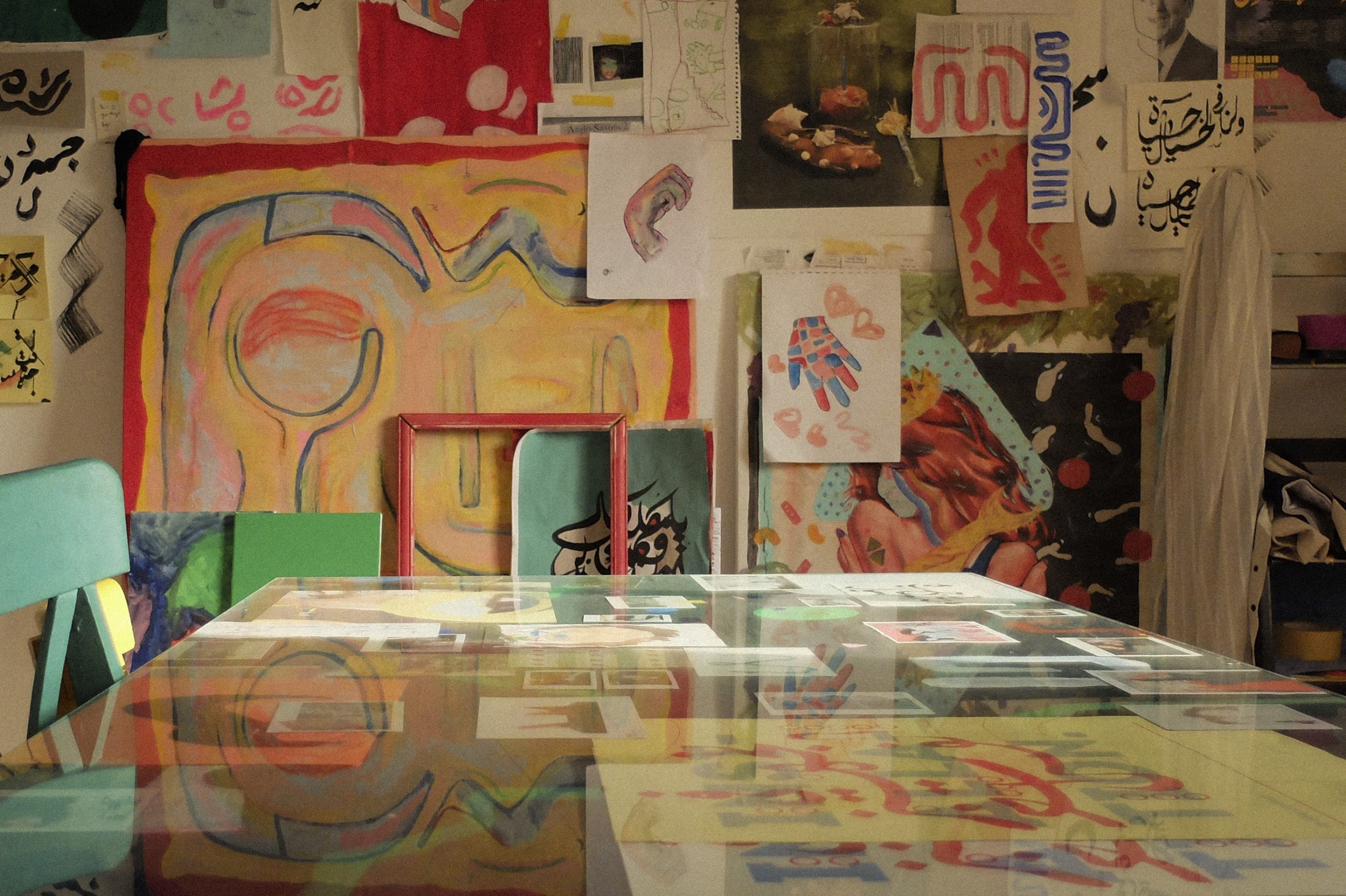
When scratches and bumps started to appear on its surface, I attempted to conserve it modestly, then not so modestly; to the point of intentionally vandalizing it. The glass top was an attempt to maintain its wood surface that later allowed for it to become a visual memoir of sorts; an open sketchbook, a relic photo album, a pandora’s box of current findings and drawn out thoughts, a time-capsule.
The room where the desk is quickly began to mirror it. This started specifically when I re-ventured into painting larger canvases.
Q: When you are creatively blocked what are some of the ways you overcome this block?
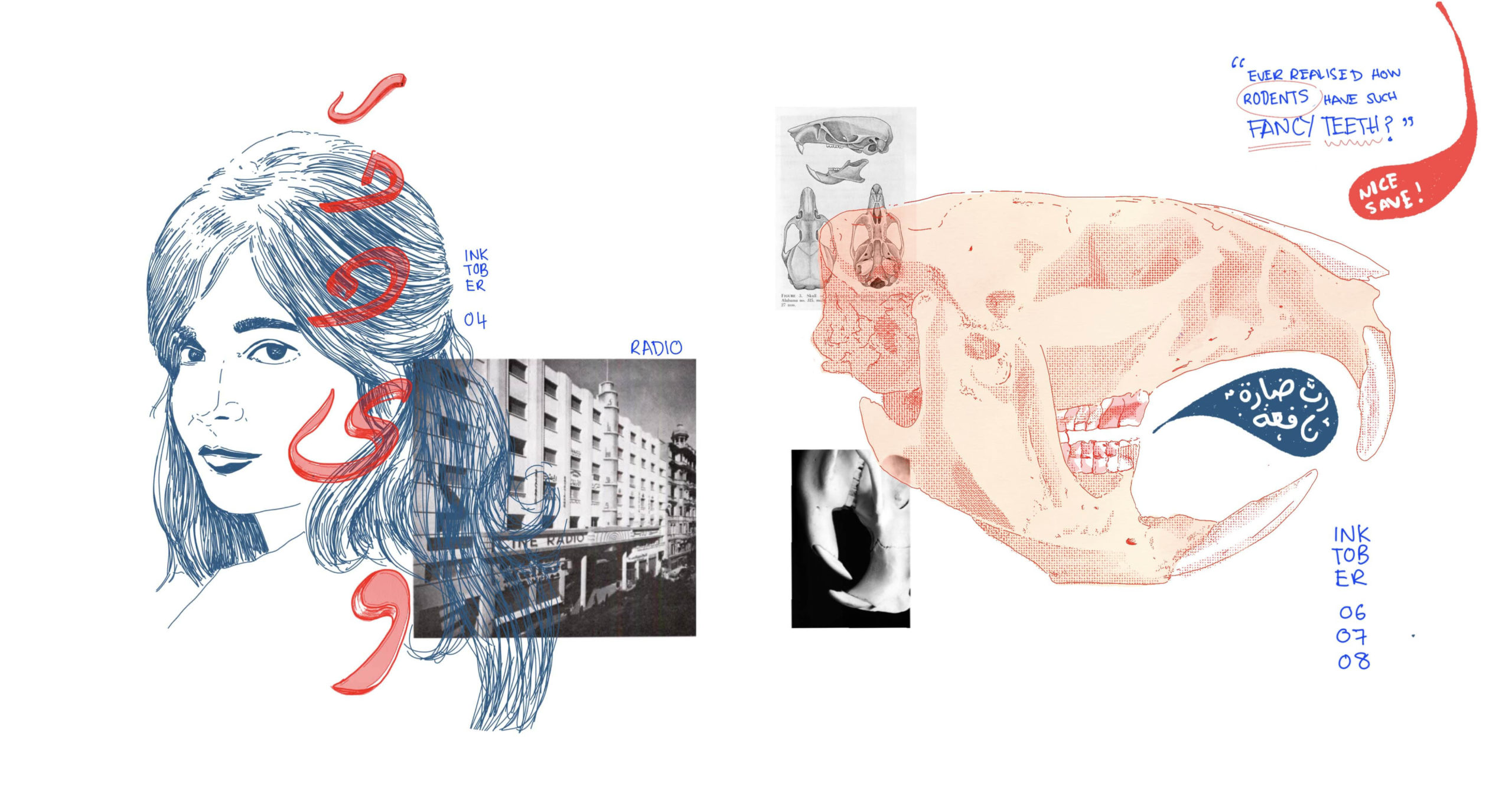
✄
All projects usually start with a process of deep thinking about directions and ideas in a self-reflective way, and the aesthetic choices that accompany them. That can take a considerable chunk of my ideation timeline (which is always the first stage in my thinking process). This tends to be followed by the act of visualizing the ideas in more tangible forms. Although I have done this over and over for the past 10 and some years, it is still daunting putting pen to paper (or stylus to screen) and actually attempting to visualize an idea.
My humble findings after studying and practicing design since the early 2000s is that blocks are inevitable, be it distraction, lack of energy or being creatively drained. These are all valid reasons to pause, re-assess and attempt to resolve the blockage. If I am creatively blocked in one project, I could switch to another project, since I usually work on multiple projects at the same time and they are more likely to overlap. Sometimes it’s good to do something completely unrelated, just to let out some steam. This could be writing, reading, cooking or dancing. This switching allows the thoughts to flow freely which usually resolves my initial block.
Another methodology (used specifically on branding projects) is that I attempt to become a user persona. So instead of Engy, 34, mother of two, Designer and Artist (who needs to get to the nursery fast before they apply a late fees penalty, I am Omar, 22, recent college graduate, interning during a gap year before my masters. I’ll try to understand what Omar wants from, let’s say, the next upcoming ‘Coffee House Brand’. It needn’t be precise, but it opens up inspirational channels that I might not have come across as ‘Engy’.
Creativity prompts can somewhat be helpful too, like the popular Inktober or 30 Days of Type Challenges, albeit I usually lose focus and stamina half way through. You’ll know I’m at a complete block though if I get up to wash the dishes or fold laundry.
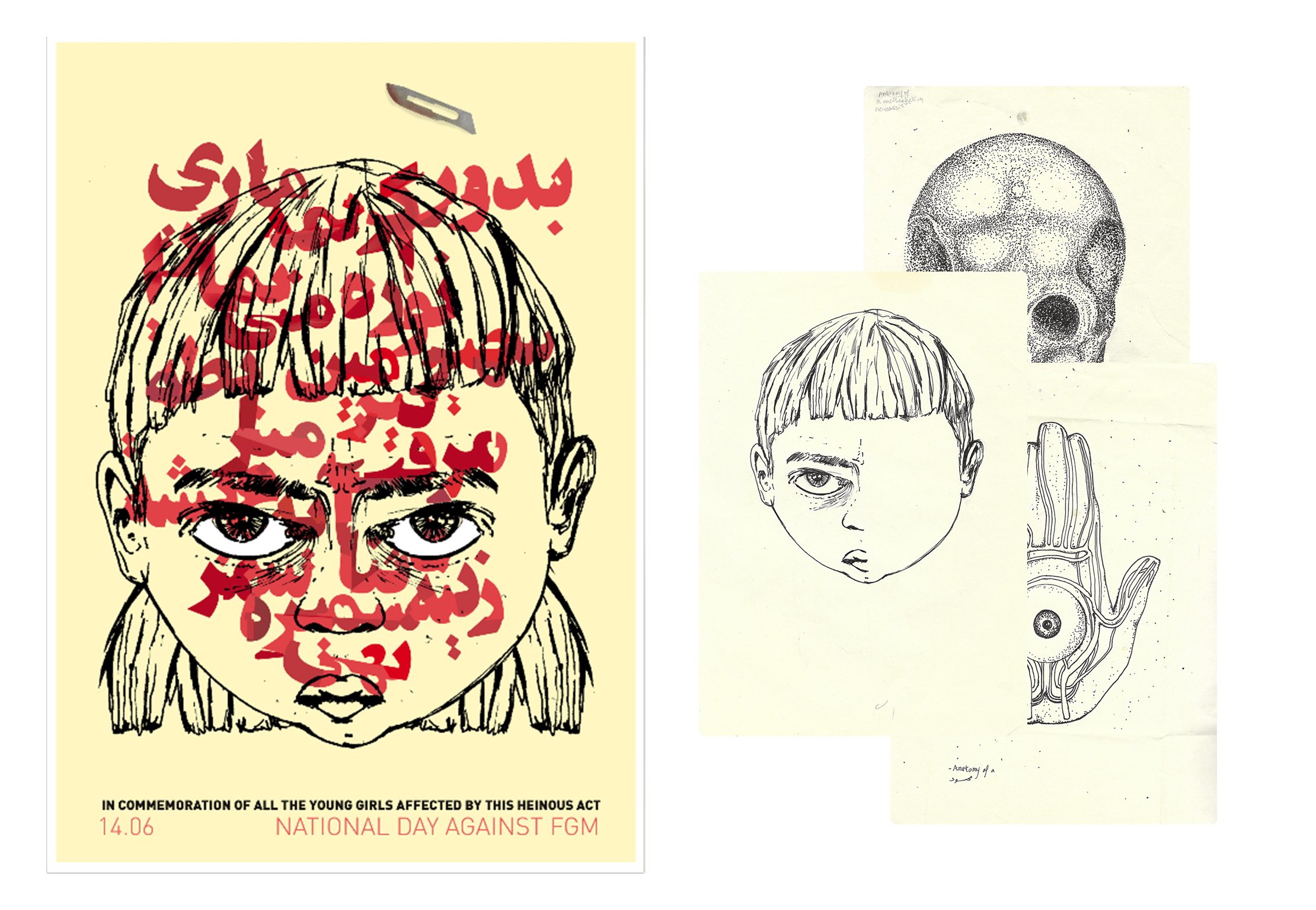
Q: You work on a lot of branding projects, is there a specific reason why you are drawn to branding?
✄
Yes. Branding or Identity Design forms a substantial bulk of my design portfolio. The opportunity to develop a client’s (sometimes incomplete) vision about a product or a service, into becoming a brand, is a treasured process; with the research, ideation and rationale development phases being the most critical and sometimes most overwhelming.
I completed my first branding project as a freshman in university for a chiropractic clinic. All I remember is that it was type based and that it was saved on a CD-ROM.
Although I now transfer work deliverables through the cloud, the element of using type or typography (manifested in logotypes) continues in most of my branding projects. Old habits do die hard. Though it is not a predetermined decision to use type, I easily slip into it sometimes; almost an automatic tendency and I practice challenging it by attempting more pictorial or abstracted options to not deny the brand at hand its possible potential.

Q: You are also a designer, an Art consultant, and an artist. How did your work within the Art space influence your practice as a designer and vice versa (if it did at all)?
✄
Art will always be my primary propagator. I gravitated towards Design due to my fondness and practice of Art growing up. My first job in a design agency only lasted about three months. I resigned in order to freelance and focus on projects that allowed me to be part of something that had more of a cultural or educational impact.
When Mathaf, The Arab Museum of Modern Art, opened in Qatar in 2010, I was fortunate to be a member of its core team as we worked towards its inauguration. My formal Western education in the Arts didn’t offer the regional context that my time at Mathaf did and I consider it foundational to my practice now.
As Lead Graphic Designer at Mathaf, I was exposed to an array of acclaimed artists and curators such as Shirin Neshaat, Wael Shawky, Dia Azzawi and the multidisciplinary curatorial platform artReoriented to list a few. I was tasked with designing and producing resources to market and educate on Mathaf’s various exhibitions and initiatives; bridging international art practices with the local community. I was introduced to the works of master artists such Mahmoud Mokhtar, Baya Moheiddine, Inji Efflatoun and countless other Arab Artists.
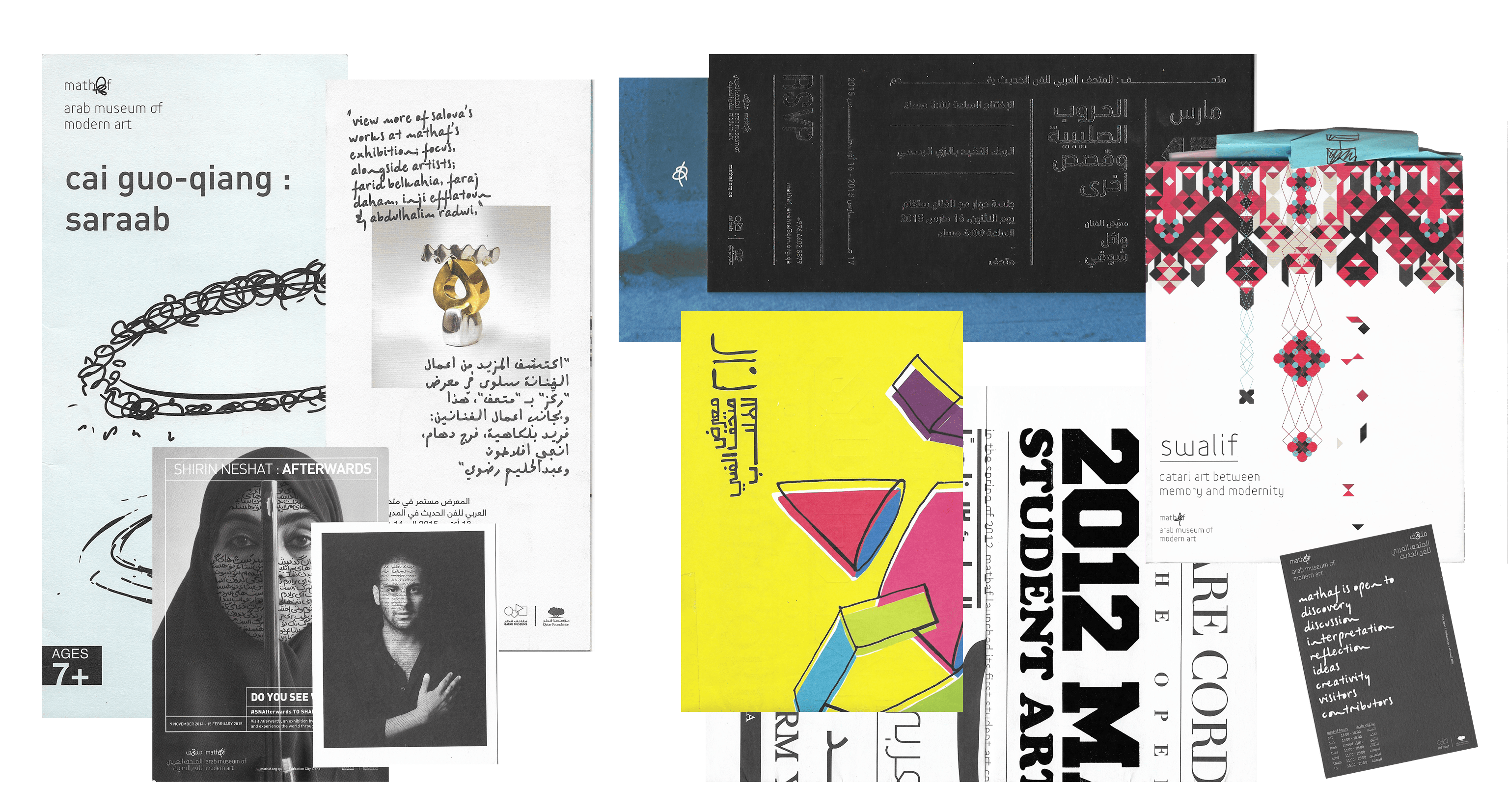
My current practice at TAM.Gallery is not that of a Graphic Designer (although I art directed and designed its current brand and several exhibition collaterals). I was inclined to add a shift to my career to sharpen my soft skills (pun intended) and therefore joined Tam’s Corporate Art team, where we, the gallery and the artists, work with corporations to deliver strategic art programs and solutions that add value to corporate environments.

The ultimate goal of creating Art is to interpret, comment on and document the present day experience to inspire, generate conversation, and broaden horizons that may eventually reshape understanding and culture. The role played by art institutions such as museums or galleries, is to accentuate that, protect it, market it, give a louder voice and wider reach than the artist might be able to do single-handedly. This is my current chosen environment.
Q: What are 3 pieces of advice you can give to a young designer embarking on a journey similar to yours? (Or if that is not a great formulation of the question, what would be your general reflections on the field of design now in Egypt as it stands?)
✄
I’ll attempt to reiterate the advice I give myself in a more mindful way, as we are not so compassionate with ourselves after all.
On Purging.
We are constantly surrounded, better yet, bombarded with visuals from our urban landscape and it would be naive to think that this doesn’t seep into the formulation of our aesthetic choices and preferences.
That’s why I consciously and deliberately create a safe mental space for myself to go through the things I get exposed to on a daily basis, and purge what needs to be purged. Allowing myself time and space to freely explore, sketch out those sometimes mediocre, ugly, or revolutionary ideas floating in my head. This usually relieves the pressure and anxiety of the creative process, freeing up space for new ideas to be generated. So make sure you purge.
On Perspective.
I’ve doubted many projects because I assessed their value from ulterior perspectives rather than my own. Self-critique is necessary, but constructively rather than cripplingly.
On Perfectionism and Patience
Admirable but attainable only through patient practice.
Done. What a rambler!